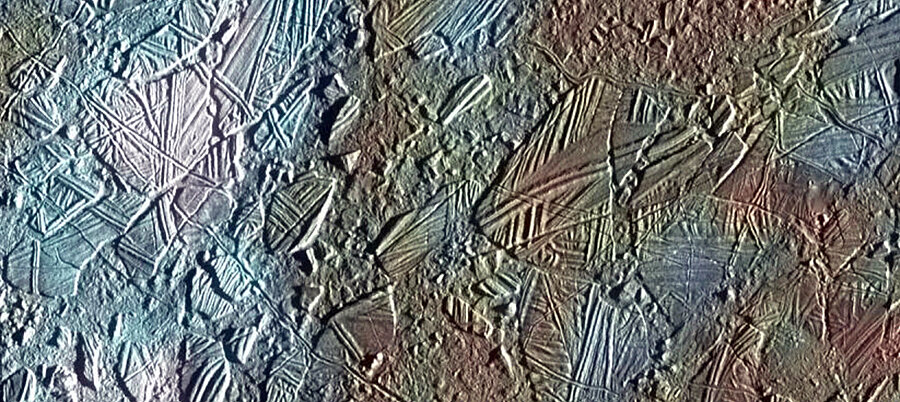Does geyser discovery vault Europa to top of list in search for life?
Loading...
Astronomers have discovered evidence for watery geysers on Jupiter's moon Europa – a long-sought “smoking gun” that signals a geologically active moon with an ocean beneath its thick crust of ice that could perhaps sustain at least simple forms of life.
They made the announcement Thursday, one that planetary scientists interested in Europa as a possible location for life have waited at least 16 years to hear.
In the late 1990s, NASA's Galileo orbiter showed clear signs of activity on the moon: smooth, relatively young expanses of ice covering older, jumbled ice fields, implying that the areas had been resurfaced. Ridges and rifts looked like smaller, frosty versions of the mountain ranges and rifts the Earth's crust forms as plates ride atop a fluid interior and collide or spread. Other measurements pointed to a fluid subsurface ocean.
But mission scientists were uncertain: Was the moon active or were the images showing features on a body that had gone dormant? What researchers really needed was evidence of geysers to prove that activity was still going on, said the late Ronald Greeley, a planetary scientist at Arizona State University at the time and a member of the team analyzing Galileo's images.
That evidence now appears to be in hand. Europa is not the only place in the solar system with geysers of liquid water. Saturn's moon Enceladus also harbors subsurface water or slush with plumes that feed Saturn's E ring. When NASA's Cassini spacecraft first returned images of the plume, the tiny moon vaulted toward the top of a short list of potentially habitable places in the solar system, beyond Earth.
Europa, however, is closer, larger, and in some respects more intriguing.
“The discovery of water geysers on Europa – and geysers by the way that are much more prolific than at Enceladus – means that we have high-priority astrobiology target that is much closer than Saturn and within reach of solar-powered missions,” says Alan Stern, a planetary scientist at the Southwest Research Institute in Boulder, Colo., who was not a member of the team reporting the discovery.
“If we're looking for life in the solar system, Europa has an ocean on the inside, it's spewing liquid water out, meaning there's a heat source. I don't know how loud Europa has to shout at us to pay attention,” he says.
The heat source on Europa, as on Enceladus, is thought to be tidal heating. This heating occurs as Jupiter's intense gravity deforms the moon as it orbits. The amount of deformation changes along the orbital path. These changes lead to friction within the Europa's interior, heating it and keeping the region between the frozen crust and the rocky mantle liquid.
The evidence for geysers suggest that the process that crinkled and repaved the moon's surface are still active today and, if confirmed, that researchers have found their smoking gun for subsurface oceans on Europa.
The team, led by Lorenz Roth, also with the Southwest Research Institute, posits that the plumes erupt when Europa is at its greatest distance from Jupiter as it orbits. There, the tension Jupiter's gravity imposes on Europa's crust is strongest, allowing fissures to open and water to vent. A similar process is thought to be at work at Enceladus.
Knowing how long it takes Europa to orbit Jupiter, it should be possible to schedule additional observations that would confirm Dr. Roth's team's results and provide additional data on the plumes, researchers say.
What's in a geyser plume? Assuming the water is coming from the subsurface ocean, it would offer evidence of the water's chemistry, Roth said in a prepared statement. “And that is tremendously exciting” because it reduces the need to drill through the ice to glean information on whether the ocean is chemically hospitable.
Two years ago, another research team reported tentative evidence for plumes using Hubble Space Telescope, but the data lacked the quality to provide much more than a teaser.
Roth's team stumbled on the plume while it was using a different instrument on Hubble – the Space Telescope Imaging Spectrometer – to study auroras that Jupiter's intense magnetic field trigger in Europa's thin atmosphere.
As the team observed the aurora at Europa's south pole, they noticed a region where the spectral signatures of oxygen and hydrogen were much higher than elsewhere – signatures that persisted for at least seven hours. They weren't there in similar observations taken the month before. And they didn't appear in images Hubble took of the moon in 1999.
Moreover, when energized electrons, such as those found in aurora, smack into water molecules, they split them, the researchers noted. The hydrogen and oxygen atoms have unique spectral signatures that scream: We were water once. These signatures also showed up.
The team estimates that the plume reached an altitude of 135 miles above the surface before falling back to spread ice crystals across an expanse some 182 miles across. Europa is six times larger that Enceladus and carries about 400 times its mass, so its gravity quickly pulls the ice plume back to the surface. Much of the Enceladus plumes escape the moon's gravity and freeze, forming Saturn's widest ring.
The Europa observations were made in November and December 2012, and the results were announced Thursday at the fall meeting of the American Geophysical Union in San Francisco, which ends Friday, as well as in a formal research report set to appear in the journal Science on Friday.
Mars will always captivate humans for potential habitability, if not for potential colonization. But for all the interest in the red planet, “I think we're finding it's dead, dead, dead, Jim,” Stern says.
We should be aiming landers at Europa, he suggests.






